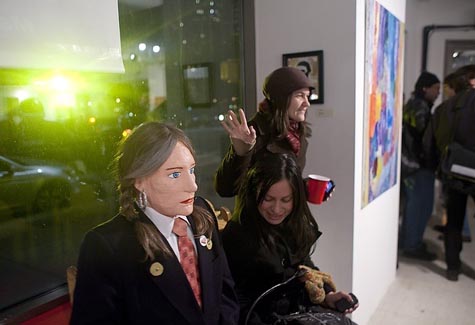What those museum guards really do at night

When Peter Hoffmeister graduated from the Fashion Institute of Technology in 2007, as an artist, he knew finding paying gigs would be tough. The first few months out of school, the Riverhead High School alum and Aquebogue native spent his days working odd jobs trying to make ends meet in New York City.
In 2008, he took a job as a guard at the Metropolitan Museum of Art for the steady income and benefits.
“I always knew I would try and find my way to the Met if I needed a job,” he said.
What he didn’t know was that many of the people watching over the museum’s priceless collection of art are, like himself, artists, writers or musicians.
“We would talk on our break about shows we’ve seen,” he said of he and the other guards. “It’s like an informal artist community.”
Last year a few of the guards, realizing the pool of talent amongst themselves, got to talking and decided to show their work to the world.
In early 2010, the first issue of Sw!pe magazine, 110 pages featuring the work of 35 Met guards, was published. About 500 copies of the magazine were sold and the publication even got a write-up in the New York Times.
“I saw this was needed for a museum,” said one of the founding editors, photographer and former Met guard Jason Eskenazi. “It was like a no-brainer.”
This year, the magazine has grown to 127 pages and features 52 artists and writers — all current and former Met guards.
“It sort of grew from this very informal idea,” Mr. Hoffmeister said. “I think a lot of people were surprised we pulled it off.”
To kick off the second issue, an exhibition was held starting with a celebration Thursday night, Feb. 10, at 25 CPW Gallery located at 25 Central Park West in Manhattan. The free exhibit was scheduled to run until Sunday, when it would culminate with live music and poetry readings performed by the museum guards.
The magazine will be available for purchase at the exhibition or by visiting Swipemagazine.com. (Note the url does not include the exclamation point.)
The magazine, which does not sell space to advertisers, is also seeking public funding.
For the second issue, artists were encouraged to use literal and figurative interpretations of the museum in their submissions, Mr. Hoffmeister said. Their submissions include critical essays, photographs of people browsing inside the museum and even poems.
Mr. Hoffmeister, who first studied art under Riverhead teacher Vincent Nasta who was killed in a plane crash in 2008, said he hopes his work will cause people to rethink their perceptions of history, knowledge and power structures. His submission to the magazine is of a blueprint of the museum reconfigured to include geographical representations.
Editors hope to include work from guards at other New York City museums in the next issue and to eventually feature submissions from around the world, Mr. Hoffmeister said.
The best part of creating the magazine for Mr. Hoffmeister is the inspiration and learning that comes with working with other artists.
“[After graduating] you’re used to having a dialogue with other artists,” he said. “I think that dialogue is important to keeping your art healthy.”






